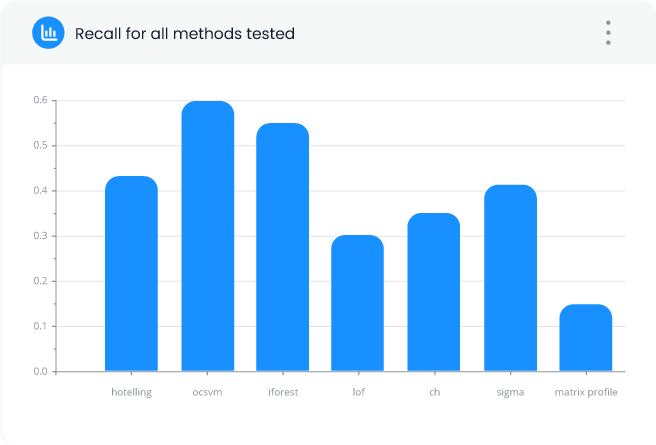Industrial machinery
anomaly detection

Anomalies detection for predictive maintenance in industrial equipment
The sensitization of mechanical and industrial proceses is gradually increasing. This is mainly due to the availability and cost reduction of sensors, and widespread use of networks.
Today, we will discuss the different backgrounds of data professionals, the challenges they face, and the skills they use on a daily basis.
This provides plant managers with more frequent and more detailed information about the current state of the equipment and the process itself. Hence, it allows a greater degree of control over the quality of an industrial process, its resulting products as well as the health of the machine used.
In this use case, we explore how Shapelets accelerated platform can be used to create a benchmark of anomaly detection algorithms, in order to find a powerful anomaly detection solution. We will use historical data collected from a temperature sensor from an internal component of a large industrial machine.
This use case serves as a true example for predictive maintenance in industrial equipment and it applies to any industrial machinery.
The Challenge
The main challenge solved with this Data App is the construction of a benchmark of anomaly detection algorithms, implemented in different python libraries, in order to find a powerful anomaly detection solution for one of the annotated time series in the Numenta Anomaly Benchmark (NAB).
Methodology
We cover the following steps to build the solution data app.
Step 1: An exploratory data analysis (EDA)
Step 2: Comparing seven anomaly detection algorithms.
Step 3: Modelapplication, visualization and comparisonofresults and anomalies.
This initial analysis found that the original data had duplicate data points, which had to be removed from the analysis.
Additionally, the case itself comes with some other complex issues, such as anomalies and duplicated data points that do not seem to follow predictable patterns, and evaluate algorithms implemented in different libraries.
Finally, we need to build visualizations that easily help understand the performance of anomaly detection.
Metrics
For this project, we chose to use simpler metrics in order to allow for a broader range of algorithms to be effectively compared: missed alarm rate, false alarm rate, recall, and execution time.
ALGORITHMS
We have compared seven anomaly detection algorithms in the benchmark:
These algorithms have been compared using the aforementioned metrics. The results obtained using the available data with each of the models provides us with all the informaiton needed to choose the best model.
SYNTHESIZED RESOLUTION
The starting point is a dataset that covers the past three months of temperature readings from an internal component of a large, expensive industrial machine. Our objective is to be able to predict the four abnormal periods indicated in blue below. By identifying these anomalies, we can take appropriate action before any damage or negative impact occurs on the industrial process.
The seven different methods, along with the metrics, are evaluated for their ability to detect anomalies and their speed.
The study found that the best and simplest method is ”sigma”, a standard deviation filter. The results obtained by this detector are described in the below figure, where detected anomalies are shown in green, false negatives in red, and false alarms in yellow.
With a sufficient large number of false positives (an alarm is triggered every time the temperature drops below 65 or above 100 degrees Celsius), three of the four anomalies are preempted by the algorithm, and in only one of them it takes 4% of the duration of an anomaly perior (2 days) to trigger the alarm, indicating that the system could be safely used for predictive maintenance.
Results
The following key results have been derived from the development of this use case:
How does Shapelets help solve this challenge?
The study found that the best and simplest method is ”sigma”, a standard deviation filter. The results obtained by this detector are described in the below figure, where detected anomalies are shown in green, false negatives in red, and false alarms in yellow.
With a sufficient large number of false positives (an alarm is triggered every time the temperature drops below 65 or above 100 degrees Celsius), three of the four anomalies are preempted by the algorithm, and in only one of them it takes 4% of the duration of an anomaly perior (2 days) to trigger the alarm, indicating that the system could be safely used for predictive maintenance.

Adrián Carrio
Leader Data Scientist
Adrián Carrio received his degree in Industrial Engineering from the University of Oviedo and his PhD in Automation and Robotics (Cum Laude) from the Technical University of Madrid. He has also worked as a researcher in Arizona State University and the Massachusetts Institute of Technology.


